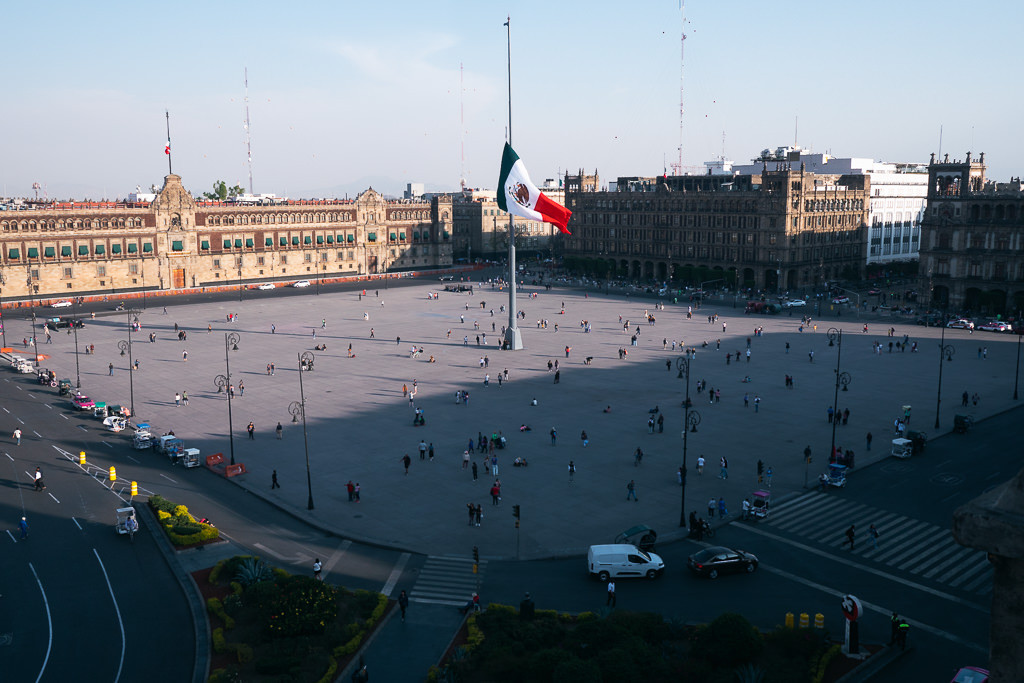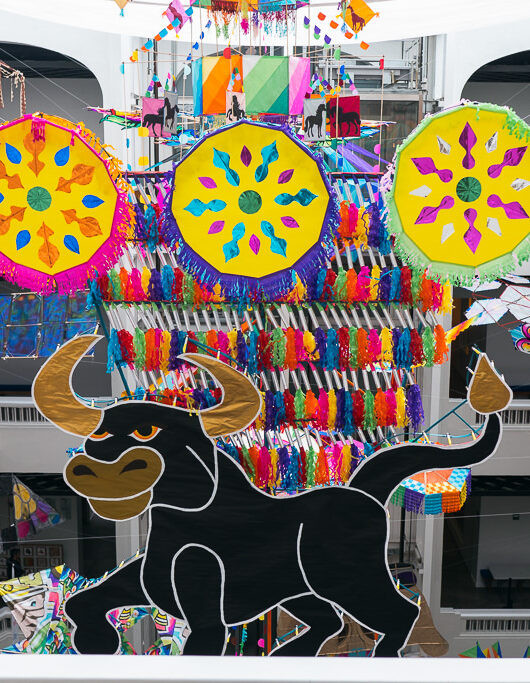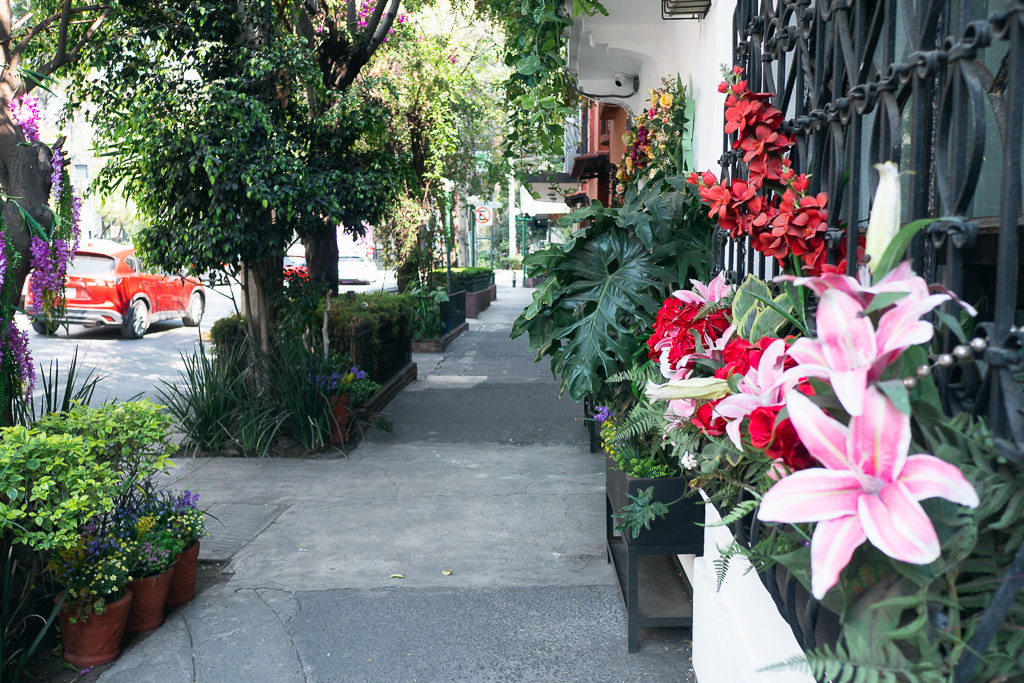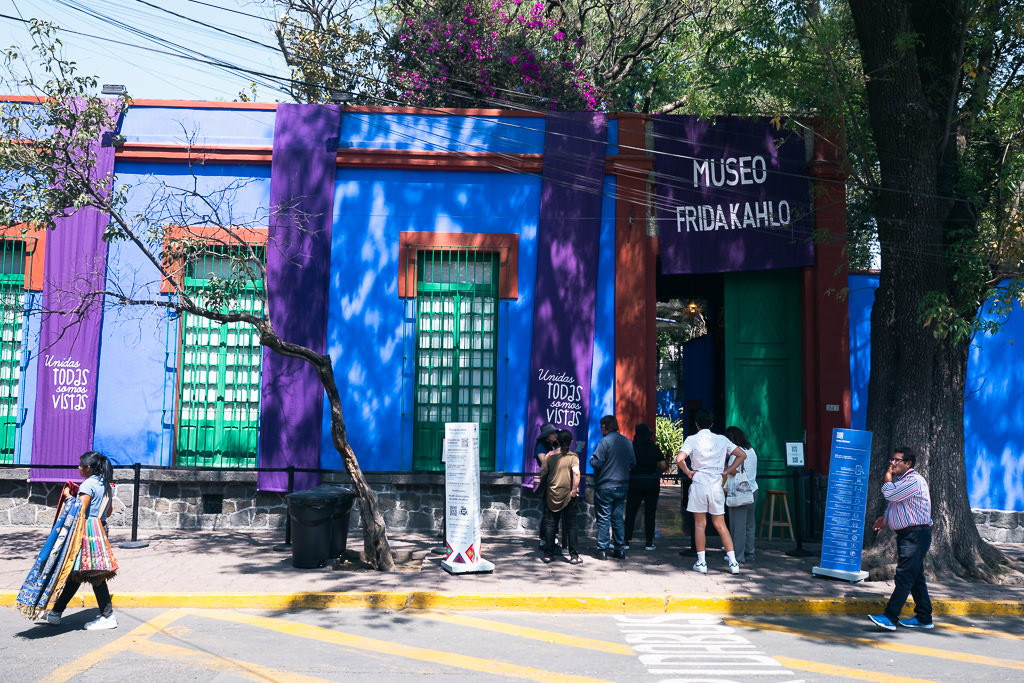Is It Worth Visiting Mexico City? Absolutely! Mexico City offers a vibrant and welcoming experience for LGBTQ+ travelers. Gaymexico.net is your go-to source for discovering the best LGBTQ+ friendly destinations, events, and accommodations in this amazing city. Prepare for an unforgettable adventure filled with culture, history, and delicious food. Find community connections, exciting nightlife, and insider travel tips, ensuring a safe and memorable vacation.
1. What is Mexico City Really Like?
Mexico City, or CDMX, is a megacity with over 22 million people. While that might sound overwhelming, it is surprisingly manageable, especially for tourists. Points of interest are clustered in walkable, safe areas like El Centro, La Condesa, and Roma. Even with the traffic and air quality issues, you can easily forget you’re in a megacity while exploring these smaller “bubbles”.
 Mexico City’s historic centre
Mexico City’s historic centre
Mexico City’s Historic Centre
2. What Makes Mexico City Worth Visiting?
Mexico City is highly worth visiting because of the many things to do. The sheer number of things to do in Mexico City can be overwhelming. You can spend days exploring without seeing everything. There are also numerous day trips and side trips, making Mexico City a perfect launching pad into central Mexico. For LGBTQ+ travelers, this means a diverse range of experiences, from historical sites to vibrant nightlife, catering to varied interests.
3. What Was The Biggest Surprise About Mexico City?
The biggest surprise about Mexico City is the sheer number of incredible museums. The city is a cultural powerhouse, possibly the best Latin American capital for museums and cultural attractions. Plan to dedicate at least a couple of days to exploring them. The stunning Anthropology Museum is unmissable, along with the Templo Mayor, Frida Kahlo Museum, and the Museum of Popular Art.
 Museum of Popular Arts
Museum of Popular Arts
Museum of Popular Arts
4. What Can You Expect From Roma and Condesa?
Roma and Condesa are popular neighborhoods where many tourists stay. These areas are hip, internationalized, and filled with well-off Mexicans, tourists, and remote workers. They’re filled with upscale restaurants, trendy cafes, beautiful parks, and artisan shops. While not representative of the rest of Mexico City, they offer a perfect introduction to CDMX, with leafy streets and an inviting atmosphere. These areas, while catering to international tastes, still offer genuine street tacos for an authentic culinary experience. If you have any doubts about Mexico City, consider booking a hostel or hotel in Roma or Condesa. Gaymexico.net offers listings of LGBTQ+-friendly accommodations in these neighborhoods.
 Flower-lined streets in Roma
Flower-lined streets in Roma
Flower-lined streets in Roma
5. How Safe Is Mexico City?
Mexico City is generally safe, especially for tourists who stick to the main areas. Most visitors are surprised that it doesn’t match imaginations about cartels. Many American visitors say it feels on par with various US cities. There is a major police presence in the center due to government buildings. Some neighborhoods that are generally safe to explore include Roma, Condesa, Centro Historico, Zona Rosa, Polanco, Coyoacan, and Juarez. It’s recommended not to wander the streets alone at night and to use official taxis or ride-share apps like Uber. General awareness against pickpocketing or theft is advised. According to the U.S. State Department, exercise increased caution due to crime.
6. How Many Days in Mexico City Is Enough?
Four days is a good minimum stay to get a feel for the city and cover some of the biggest highlights. Seven days is ideal for a more complete experience. Besides exploring the city, you’ll want to do some day trips, like the pyramids of Teotihuacan. With many museums, markets, and cultural sights, you’ll want at least 2 or 3 days to see the top ones at a relaxed pace. If you’re not into very large cities, that can be an argument for spending fewer days in the capital.
7. What LGBTQ+ Specific Attractions and Areas Exist?
Mexico City boasts the Zona Rosa, known for its LGBTQ+ friendly atmosphere with numerous gay bars, clubs, and restaurants. According to a survey conducted by the Mexico City government, Zona Rosa is considered the primary LGBTQ+ entertainment hub. The city also hosts an annual Pride celebration that is one of the largest in Latin America.
8. How Does Mexico City Compare to Other Destinations in Mexico for LGBTQ+ Travelers?
While Puerto Vallarta is often touted as the “gay beach capital” of Mexico, Mexico City offers a more diverse and cosmopolitan experience. According to Equaldex, Mexico City has strong legal protections for LGBTQ+ individuals. Gaymexico.net provides detailed comparisons, helping you choose the best destination based on your preferences.
9. What Are the Laws and Social Attitudes Towards LGBTQ+ People in Mexico City?
Mexico City has progressive laws regarding LGBTQ+ rights. Same-sex marriage has been legal since 2010, and there are protections against discrimination. According to Human Rights Watch, Mexico City has been at the forefront of LGBTQ+ rights in Latin America. While social attitudes are generally accepting, it’s always wise to be aware of your surroundings, especially in less touristy areas.
10. What Events and Festivals Cater Specifically to the LGBTQ+ Community?
Mexico City Pride, usually held in June, is a massive celebration with parades, concerts, and parties. The Mix Mexico Film Festival showcases LGBTQ+ cinema. Various smaller events and gatherings occur throughout the year; Gaymexico.net maintains an updated calendar of events to keep you informed.
11. What Are the Top Reasons to Visit Mexico City as an LGBTQ+ Traveler?
Mexico City is a must-visit for LGBTQ+ travelers because of its rich cultural scene, progressive laws, and vibrant LGBTQ+ community centered around Zona Rosa. The city offers a mix of historical sites, modern amenities, and inclusive spaces, making it a top destination. According to the International LGBTQ+ Travel Association (IGLTA), Mexico City is a welcoming and diverse travel destination.
12. How Does Mexico City Support LGBTQ+ Tourism?
The Mexico City government actively supports LGBTQ+ tourism through initiatives promoting inclusivity and safety. They work with local businesses to ensure a welcoming environment. Mexico City’s tourism board also participates in LGBTQ+ travel fairs and conferences, signaling their commitment. According to the Mexico City Tourism Board, they aim to make the city a premier destination for LGBTQ+ travelers.
13. What Safety Tips Should LGBTQ+ Travelers Keep in Mind?
While Mexico City is generally safe, it’s essential to stay aware of your surroundings. Avoid walking alone in less-lit areas at night. Use ride-sharing apps or registered taxis. Keep valuables secure. According to the U.S. Embassy, exercising common sense and caution can help ensure a safe trip.
14. What Resources Does Gaymexico.net Offer for Planning a Trip to Mexico City?
Gaymexico.net offers comprehensive travel guides, up-to-date event listings, and recommendations for LGBTQ+-friendly accommodations and venues. It also provides insights into local culture and customs, helping you make the most of your visit. Visit Gaymexico.net for detailed information, community forums, and direct connections with local businesses.
15. How Can You Connect with the Local LGBTQ+ Community in Mexico City?
Connecting with the local LGBTQ+ community enhances your travel experience. Attend events in Zona Rosa. Visit LGBTQ+ community centers. Use social media to find local groups and gatherings. Gaymexico.net provides listings of community organizations and online forums. Connecting with locals offers unique insights and friendships.
16. What Are Some Lesser-Known LGBTQ+ Spots in Mexico City?
Beyond Zona Rosa, explore smaller bars and clubs in neighborhoods like Roma and Condesa. Check out local art galleries and cultural centers that often host LGBTQ+ events. Gaymexico.net features hidden gems recommended by local insiders. Venture beyond the typical tourist spots for a more authentic experience.
17. What is the Best Time of Year to Visit Mexico City?
The best time to visit Mexico City is during the shoulder seasons (March-May and September-November). The weather is pleasant, and there are fewer crowds. June is popular due to Pride, but it can be rainy. According to climate data, the shoulder seasons offer the best balance of weather and fewer tourists.
18. How Do You Get Around Mexico City?
Mexico City has a robust public transportation system, including the Metro, buses, and trolleybuses. Ride-sharing apps like Uber and Didi are also readily available. The Metro is efficient but can be crowded during peak hours. Using a combination of transportation methods ensures you get to explore all corners of the city. According to a local transportation study, the Metro is the most used form of public transport.
19. What Cultural Experiences Should LGBTQ+ Travelers Not Miss?
Visit historical sites like the Templo Mayor. Explore the Frida Kahlo Museum. Attend a Lucha Libre wrestling match. Sample local cuisine at markets and street food stalls. These cultural experiences provide a deeper understanding of Mexico City’s heritage. According to UNESCO, Mexico City has numerous World Heritage sites.
20. What Types of Accommodations are Recommended for LGBTQ+ Travelers?
Consider staying in LGBTQ+-friendly hotels in Zona Rosa, Roma, or Condesa. Boutique hotels and guesthouses often offer a more personalized experience. Gaymexico.net provides a curated list of accommodations that prioritize inclusivity and comfort. Select accommodations that align with your travel style and values.
21. What Day Trips Should You Consider from Mexico City?
Visit the Teotihuacan pyramids. Explore the charming town of Puebla. Discover the natural beauty of Xochimilco. These day trips offer a break from the city and showcase the diversity of central Mexico. According to travel guides, these day trips are popular for their historical and cultural significance.
22. What Should You Know About Local Customs and Etiquette?
Learning a few basic Spanish phrases is always appreciated. Dress respectfully when visiting religious sites. Be mindful of noise levels in residential areas. Understanding local customs enhances your interactions with locals. According to cultural experts, respecting local customs fosters positive relationships.
23. What Specific Travel Insurance Should LGBTQ+ Travelers Consider?
Ensure your travel insurance covers medical emergencies, theft, and trip cancellations. Some policies offer specific coverage for LGBTQ+ travelers, including protection against discrimination. Check the fine print to ensure the policy meets your needs. According to travel insurance experts, comprehensive coverage is essential for peace of mind.
24. What are the Best Apps for Navigating Mexico City?
Use Google Maps for directions. Download the Metro app for real-time updates. Install ride-sharing apps like Uber or Didi. These apps make getting around Mexico City easier. According to tech experts, these apps are essential for urban navigation.
25. How Can You Stay Updated on LGBTQ+ News and Events in Mexico City?
Follow Gaymexico.net for the latest news and event listings. Subscribe to local LGBTQ+ publications. Join social media groups and forums. Staying informed ensures you don’t miss out on important events. According to media analysts, staying updated is crucial for community engagement.
26. What is the Cost of Visiting Mexico City?
Mexico City can be an affordable destination. Accommodation, food, and transportation are generally cheaper than in many Western countries. Budget travelers can easily get by on $50-$75 per day. Mid-range travelers should budget $100-$150 per day. According to budget travel guides, Mexico City offers excellent value for money.
27. What Local Cuisine Should You Try?
Sample tacos al pastor, enchiladas, mole poblano, and chiles en nogada. Visit local markets for authentic flavors. Don’t be afraid to try street food; just ensure it’s from a reputable vendor. According to culinary experts, Mexican cuisine is rich and diverse.
28. How Can You Give Back to the Local LGBTQ+ Community While Traveling?
Support LGBTQ+ owned businesses. Volunteer at a local community center. Donate to LGBTQ+ organizations. Giving back leaves a positive impact on the community. According to philanthropic experts, supporting local causes is meaningful.
29. What Emerging Trends are Shaping LGBTQ+ Tourism in Mexico City?
More boutique hotels and guesthouses are catering specifically to LGBTQ+ travelers. There’s a growing focus on cultural and historical tours that highlight LGBTQ+ contributions. Digital platforms are making it easier to connect with local businesses and communities. According to tourism analysts, these trends are enhancing the LGBTQ+ travel experience.
30. What Makes Mexico City Unique Compared to Other Global LGBTQ+ Destinations?
Mexico City combines a rich cultural heritage with a progressive social environment. It offers a diverse range of experiences, from historical sites to vibrant nightlife. The city’s affordability and welcoming atmosphere make it stand out. According to travel experts, Mexico City offers a unique blend of culture, history, and inclusivity.
31. What are the best options for Internet and Communication?
Free Wi-Fi is widely available in cafes, restaurants, and hotels. Purchasing a local SIM card provides reliable internet access. Staying connected ensures you can navigate the city and stay in touch. According to tech reviewers, local SIM cards are cost-effective.
32. How can you find reliable medical assistance in Mexico City?
Consult your embassy or consulate for a list of recommended doctors and hospitals. Ensure your travel insurance covers medical expenses. Familiarize yourself with local emergency numbers. Knowing where to seek medical assistance provides peace of mind. According to health experts, planning for medical emergencies is wise.
33. What considerations should transgender and gender non-conforming travelers keep in mind?
Mexico City is generally accepting, but it’s wise to carry identification that matches your gender presentation. Be aware of restroom policies, although many establishments are becoming more inclusive. Connecting with local transgender communities provides support and information. According to transgender advocates, preparation and community support are key.
34. What specific legal protections are available for LGBTQ+ tourists?
Mexico City has laws protecting against discrimination based on sexual orientation and gender identity. These laws apply to both residents and tourists. Knowing your rights empowers you to address any issues that may arise. According to legal experts, understanding local laws is important.
35. How can you support sustainable and responsible tourism practices?
Choose eco-friendly accommodations. Support local businesses. Respect local customs and traditions. Minimize your environmental impact. Sustainable tourism benefits the community and preserves the environment. According to sustainability advocates, responsible travel makes a difference.
36. Is Mexico City safe for solo LGBTQ+ travelers?
Mexico City can be safe for solo LGBTQ+ travelers, but it’s crucial to take precautions. Stay in well-lit, populated areas. Avoid walking alone at night. Use ride-sharing apps or registered taxis. According to solo travel experts, preparation and awareness are essential.
 The blue facade of the Frida Kahlo Museum
The blue facade of the Frida Kahlo Museum
The blue facade of the Frida Kahlo Museum
37. What are some popular Spanish phrases that would be helpful?
- Hola (Hello)
- Gracias (Thank you)
- De nada (You’re welcome)
- Por favor (Please)
- ¿Dónde está…? (Where is…?)
- ¿Cuánto cuesta? (How much does it cost?)
- No hablo español (I don’t speak Spanish)
According to language experts, knowing basic phrases enhances your interactions.
38. What resources are available for LGBTQ+ asylum seekers or refugees in Mexico City?
Organizations like the UNHCR and local LGBTQ+ advocacy groups offer support and resources for asylum seekers and refugees. These resources include legal assistance, housing, and social services. According to refugee advocates, accessing support is vital.
39. How can you ensure your safety when using dating apps in Mexico City?
Meet in public places for the first few dates. Let a friend know your plans. Be cautious about sharing personal information. Trust your instincts. According to online safety experts, taking precautions is essential.
40. What are the best neighborhoods to explore for LGBTQ+ culture?
Zona Rosa is the heart of the LGBTQ+ scene, with numerous bars, clubs, and restaurants. Roma and Condesa offer a more laid-back atmosphere with trendy cafes and boutiques. Coyoacan offers a historic and artistic vibe. According to local guides, these neighborhoods showcase the diversity of LGBTQ+ culture.
Ready to explore Mexico City? Visit gaymexico.net for the most up-to-date information, travel guides, and community connections. Discover the best LGBTQ+ friendly destinations, events, and accommodations. Plan your safe and unforgettable adventure today.
Address: 3255 Wilshire Blvd, Los Angeles, CA 90010, United States
Phone: +1 (213) 380-2177
Website: gaymexico.net
